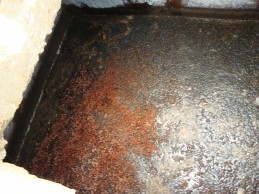The problem of how to manage wastewater from wet coffee processing has haunted the coffee industry for many years. Alan Tulip, Director of Kahangi Estate, has been extensively researching and pioneering new natural methods of handling coffee waste.
These rely on using natural means to break down the wastewater, allowing it to be usefully recycled or discharged without massive negative impacts on the environment.
At Kahangi Estate all the waste water and coffee cherry skins are fed through a digester which allows all the nutrients to be applied back to the crops by means of overhead sprinklers
The Problem of Coffee Waste
Wet processing, when the harvested coffee cherries are pulped within 24 hours of picking, provides a better quality of coffee. However, this uses a lot of water and there are two principle problematic waste products. The first, the waste water contains a lot of mucilage and goes acidic with a very bad smell. The second, the cherry skins, decompose very slowly and also has a very bad smell. The light parchment husk, left after the wet processed coffee has dried, can be more easily be recycled or used as fuel.
Safely Returning Waste to Crops
After extensive work, the coffee wastewater management system was initially developed at Kahangi Estate, where the wastewater and cherry skins are digested and recycled back to the crops. The pictures shows waste water being discharged from a small treatment plant designed by Alan Tulip for a wet mill in Mount Elgon, Uganda. The natural vegetation growing in the stream demonstrates the minimal impact of the coffee waste water.
Coffee Wastewater Management System for Small and Large Coffee Processors
The methods have been incorporated in units which process up to 80 tons of cherry a day, as well as small units processing 2 tons or less of cherry per day. Coffee waste management units have consequently been developed in Uganda, Congo, Papua New Guinea, Indonesia and Vietnam.
For More Information:
Alan Tulip +256 772 708207 e-mail: aptulip@infocom.co.ug
Kahangi Estate, Box 282, Fort Portal, Uganda



